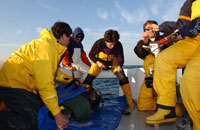
Here's another take on Saturday's tagging from Aaron Spares, one of the field scientists tagging in Port Hood...
Sunrise was a pink sky highlighted with gold-rimmed stratus clouds, the kinda morning sky that turns to satin streams as the day goes on. Gannets soared everywhere as they and tuna boats fished for ‘pig-sized’ mackerel. Steaming offshore brought more birds, gulls and guillemots, but no tuna. Off the Mull River, the first few gannets started pluggin’ surface bait. A tuna ripped a white streak through the surface under them, followed soon after by ½ a dozen more. We set up and reset numerous times near events inshore, but only had our first marks o’the day by 11:18. We headed outside to a hotspot termed ‘The Sharkfin’, markin’ bait as we steamed.
The radio cracks with the voice of Captain Bruce Keus of the ‘S/V North Lake Breeze’ outside of us, “Fish up! Gotta go!”
Other TAG vessels report similar activity. We waited with baited breath, feeding our building excitement with early Halloween treats. Birds began to gather around the ‘S/V Bay Queen’. ‘Were we the startin’ line?’ What little wind there was had us lulled into believin’ we were headed towards what Capers call “a flat-ass cam” day. By noon, the sounder showed two solid green bands of bait, one shallow, one deep. Kites were deployed, dropped and redeployed, desperately trying to take advantage of the light breeze. A lone Sei whale surfaced off our stern.
“On there Dennis?” the radio sounded at 12:13 with Capt’n Bernie Chisholm of the ‘S/V Nicole Brandy’, “We’re hooked up here.”
The game, and our taggin’ day, began. By 13:13, #1 tagged tuna was back in the water with tags attached. An hour later, we marked a fish deep and soon after our ‘Huey’ surface bait screamed off the reel. The fish remained high, makin’ our line chaffer, a soother to shield the leader line from a tuna’s sharp teeth, useless. The line snapped after a 27-minute battle. ‘Catcha later tuna #2.’ With the wind pickin’ up, Capt’n Steve MacInnis of the ‘S/V Carrie Anne’ hooked up tuna #3 at 15:33. After comin’ aboard the ‘Bay Queen’ with his hooked up rod, he fought the fish for 2 hours, bringing the giant to the surface only once before it dove deep beside the boat doubling over the rod like it had been kicked in the groin. With a sharp crack, it snapped off at the base of shaft. The reel with a baseball bat thick stub left became the TAG team’s only weapon against this monster. With Capt’n Steve MacInnis and Dennis Cameron hand-linin’, Dr. Steve Wilson reelin’ in slack and PhD student Aaron Spares protecting the monofilament from sharp edges of the gunwale with a mat, the monster was brought to the surface once more. Its powerful tail, as thick as a Husky sled dog’s shoulders are wide, still pumped water over the crew fighting it from the stern. The line tightened and released. The fish swam away. The crew was left with two more fish hooked up by other vessels. In the increasing wind, gusting to 20 knots, with waves floodin’ the back deck of the ‘Bay Queen’ through the transom door, the TAG team tagged tuna #4 in the gathering dark and stomached the message tuna #5 broke off. TUNA = 3. TAG = 2. May these giants bite again when the wind lets the TAG team out another day.





















































